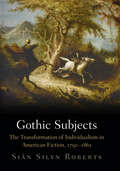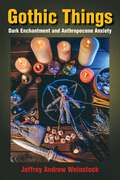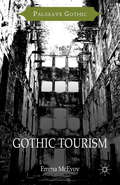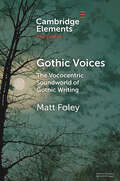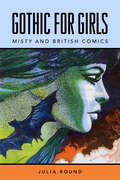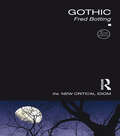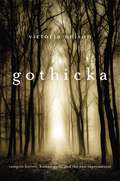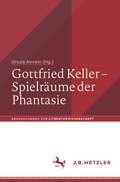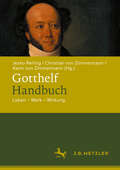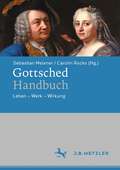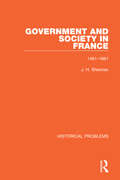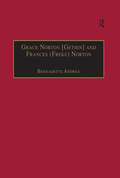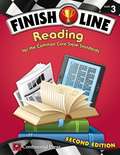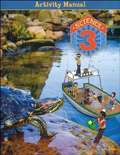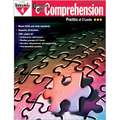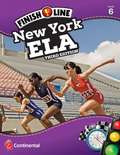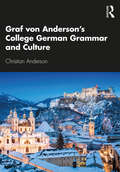- Table View
- List View
Gothic Subjects: The Transformation of Individualism in American Fiction, 1790-1861
by Siân Silyn RobertsBeginning in the 1790s, North American readers developed an appetite for the gothic novel, as imported, reprinted, and pirated editions of British and European romances flooded the market alongside homegrown works. In Gothic Subjects, Siân Silyn Roberts accounts for the sudden and considerable appeal of the gothic during this period by contending that it prepared a culturally diverse American readership to think of itself as part of a transatlantic world through which goods, people, and information could circulate. By putting gothic literature in dialogue with the writings of Locke, Hume, Reid, Smith, Rousseau, and other major figures of the European Enlightenment, Silyn Roberts shows how the early American novel participated in the process of revising and transforming the figure of the modern individual for a fluid, contingent Atlantic population.Exploring works of fiction by Charles Brockden Brown, Leonora Sansay, Sally Sayward Barrell Keating Wood, Edgar Allan Poe, Robert Montgomery Bird, Nathaniel Hawthorne, and William Wells Brown, among others, Silyn Roberts argues that the gothic helped post-Revolutionary readers to think of themselves as political subjects. By reading the emergence of a national literary style in terms of its appropriation and reinterpretation of British cultural forms, Gothic Subjects situates itself at the crux of several important issues in American literary history: transatlantic literary relations, the connection between literature and political philosophy, the paradoxes of sovereign power, and the form of the novel. In doing so, Gothic Subjects powerfully rethinks some of our previous assumptions about the cultural work of the American gothic tradition.
Gothic Things: Dark Enchantment and Anthropocene Anxiety
by Jeffrey Andrew WeinstockSHORTLISTED, THE ALLAN LLOYD SMITH PRIZE FOR BEST MONOGRAPHOffering an innovative approach to the Gothic, Gothic Things: Dark Enchantment and Anthropocene Anxiety breaks ground with a new materialist analysis of the genre, highlighting the ways that, since its origins in the eighteenth century, the Gothic has been intensely focused on “ominous matter” and “thing power.” In chapters attending to gothic bodies, spaces, books, and other objects, Gothic Things argues that the Gothic has always been about what happens when objects assume mysterious animacy or potency and when human beings are reduced to the status of just one thing among many—more powerful—others.In exploring how the Gothic insistently decenters the human, Jeffrey Andrew Weinstock reveals human beings to be enmeshed in networks of human and nonhuman forces mostly outside of their control. Gothic Things thus resituates the Gothic as the uncanny doppelgänger of twenty-first-century critical and cultural theory, lurking just beneath the surface (and sometimes explicitly surfacing) as it haunts considerations of how human beings interact with objects and their environment. In these pages the Gothic offers a dark reflection of the contemporary “nonhuman turn,” expressing a twenty-first-century structure of feeling undergirded by anxiety over the fate of the human: spectrality, monstrosity, and apocalypse.Substituting horror for hope, the Gothic, Weinstock explains, has been a philosophical meditation on human relations to the nonhuman since its inception, raising significant questions about how we can counter anthropocentric thought in our quest to live more harmoniously with the world around us.
Gothic Topographies: Language, Nation Building and ‘Race’
by Matti SavolainenIn demonstrating the global reach of Gothic literatures, this collection takes up the influence of the Gothic mode in literatures that may be geographically remote from one another but still share related issues of minor languages, nation building, place and race. Suggesting that there is a parallel between certain motifs and themes found in the Gothic of the North (Scandinavia, Northern Europe and Canada) and South (Australia, South Africa and the US South), the essays explore the transgressions and confusion of borders and limits, whether they be linguistic, literary, generic, class-based, gendered or sexual. The volume includes essays on a wide diversity of authors and topics: Jan Potocki, Gustav Meyrink, William Godwin, Alan Hollinghurst, Marlene van Niekerk, John Richardson, antislavery discourse and the Gothic imagination, the Australian aboriginal Gothic, vampires of Post-Soviet Gothic society, Danish, Swedish and Finnish fiction and film, and the Canadian female Gothic and the death drive. What distinguishes this book from other collections on the Gothic is the coverage of themes and literatures that are either lacking in the mainstream research on the Gothic or are referred to only briefly in other book-length studies. Experts in the Gothic and those new to the field will appreciate the book's commitment to situating Gothic sensibilities in an international context.
Gothic Tourism: Constructing Haunted England (Palgrave Gothic)
by Emma McEvoyFrom Strawberry Hill to The Dungeons, Alnwick Castle to Barnageddon, Gothic tourism is a fascinating, and sometimes controversial, area. This lively study considers Gothic tourism's aesthetics and origins, as well as its relationship with literature, film, folklore, heritage management, arts programming and the 'edutainment' business.
Gothic Voices: The Vococentric Soundworld of Gothic Writing (Elements in the Gothic)
by Matt FoleyThis Element provides new ways of reading the soundscape of the Gothic text. Drawing inspiration from the field of 'sonic Gothic' studies, which has been spearheaded by the writings of Isabella van Elferen, as well as from Mladen Dolar's articulation of the psychoanalytic 'object' voice, this study introduces the critical category of 'vococentric Gothic' into Gothic scholarship. In so doing, it reads important moments in Gothic fiction when the voice takes precedence as an uncanny, monstrous or seductive object. Historically informed, the range of readings proffered demonstrate the persistence of these vocal motifs across time (from the Gothic romance to contemporary Gothic) and across intermedia forms (from literature to film to podcasts). Gothic Voices, then, provides the first dedicated account of voices of terror and horror as they develop in the Gothic mode from the Romantic period until today.
Gothic for Girls: Misty and British Comics
by Julia RoundWinner of the 2019 Broken Frontier Award for Best Book on ComicsToday fans still remember and love the British girls’ comic Misty for its bold visuals and narrative complexities. Yet its unique history has drawn little critical attention. Bridging this scholarly gap, Julia Round presents a comprehensive cultural history and detailed discussion of the comic, preserving both the inception and development of this important publication as well as its stories. Misty ran for 101 issues as a stand-alone publication between 1978 and 1980 and then four more years as part of Tammy. It was a hugely successful anthology comic containing one-shot and serialized stories of supernatural horror and fantasy aimed at girls and young women and featuring work by writers and artists who dominated British comics such as Pat Mills, Malcolm Shaw, and John Armstrong, as well as celebrated European artists. To this day, Misty remains notable for its daring and sophisticated stories, strong female characters, innovative page layouts, and big visuals.In the first book on this topic, Round closely analyzes Misty’s content, including its creation and production, its cultural and historical context, key influences, and the comic itself. Largely based on Round’s own archival research, the study also draws on interviews with many of the key creators involved in this comic, including Pat Mills, Wilf Prigmore, and its art editorial team Jack Cunningham and Ted Andrews, who have never previously spoken about their work. Richly illustrated with previously unpublished photos, scripts, and letters, this book uses Misty as a lens to explore the use of Gothic themes and symbols in girls’ comics and other media. It surveys existing work on childhood and Gothic and offers a working definition of Gothic for Girls, a subgenre which challenges and instructs readers in a number of ways.
Gothic: Critical Concepts In Literary And Cultural Studies (The New Critical Idiom)
by Fred BottingThis enduringly popular book has become a classic in the expanding and increasingly popular field of Gothic Studies. This long awaited new edition contains a new chapter on ‘Contemporary Gothic’, an expanded section on American Gothic and more discussion of the gothic in women’s film and writing throughout the book. It is also updated in relation to media and technology with further discussion of stage sensations and photography as well as engaging with all major texts and criticism since initial publication in 1995. With the added benefit of series features such as a glossary and annotated further reading section, this remains the ideal guide to the Gothic.
Gothicka
by Victoria NelsonThe Gothic, Romanticism's gritty older sibling, has flourished in myriad permutations since the eighteenth century. In Gothicka, Victoria Nelson identifies the revolutionary turn it has taken in the twenty-first. Today's Gothic has fashioned its monsters into heroes and its devils into angels. It is actively reviving supernaturalism in popular culture, not as an evil dimension divorced from ordinary human existence but as part of our daily lives. To explain this millennial shift away from the traditionally dark Protestant post-Enlightenment Gothic, Nelson studies the complex arena of contemporary Gothic subgenres that take the form of novels, films, and graphic novels. She considers the work of Dan Brown and Stephenie Meyer, graphic novelists Mike Mignola and Garth Ennis, Christian writer William P. Young (author of The Shack), and filmmaker Guillermo del Toro. She considers twentieth-century Gothic masters H. P. Lovecraft, Anne Rice, and Stephen King in light of both their immediate ancestors in the eighteenth century and the original Gothic-the late medieval period from which Horace Walpole and his successors drew their inspiration. Fictions such as the Twilight and Left Behind series do more than follow the conventions of the classic Gothic novel. They are radically reviving and reinventing the transcendental worldview that informed the West's premodern era. As Jesus becomes mortal in The Da Vinci Code and the child Ofelia becomes a goddess in Pan's Labyrinth, Nelson argues that this unprecedented mainstreaming of a spiritually driven supernaturalism is a harbinger of what a post-Christian religion in America might look like.
Gottfried Keller – Spielräume der Phantasie (Abhandlungen zur Literaturwissenschaft)
by Ursula AmreinDie in diesem Band versammelten Beiträge zeigen Keller als einzigartigen Erzähler, richten den Blick auf Texte aus dem Nachlass, gehen seinen Träumen und Phantasien nach, verfolgen seine Spuren als Maler, diskutieren seine Theaterprojekte, erläutern seine Beziehung zur Musik und vergegenwärtigen ihn als Politiker. Lektüren, die diesen unterschiedlichen Zusammenhängen Rechnung tragen, bringen pointiert neue Erkenntnisse in die Auseinandersetzung mit Gottfried Keller und seinem Werk ein.
Gotthelf-Handbuch: Leben – Werk – Wirkung
by Jesko Reiling Christian Von Zimmermann Karin Von ZimmermannSeit zwanzig Jahren setzt die Forschung zu Leben, Werk und Wirken von Jeremias Gotthelf neue Akzente. Sie erkundet die innovative Poetik seiner volkspädagogischen Erzählungen als Alternative zu gängigen Traditionen realistischen Erzählens, und sie ersetzt das Bild des Moralpredigers durch jenes eines aufgeklärten und modernen Pfarrers. An die Stelle des reaktionären Bauerndichters tritt das Bild eines Analytikers der ökonomischen und sozialen Bedingungen der Armut. Früh sah Gotthelf die Problemseiten der Industrialisierung und erkannte genauso die Folgen eines Festhaltens an alten Formen des Wirtschaftens. Sein Einsatz für die Schule korrespondierte mit zeitgemäßen pädagogischen Bemühungen; sein publizistisches Wirken diente den Prozessen der politischen Meinungsbildung in einer für ihre Zeit freien republikanischen Gesellschaft. Begriffe wie Freiheit, Gleichheit, Mündigkeit, Fürsorge, Kommunalität und Anthropologie prägen die Gotthelf-Debatten der letzten Jahre. Gotthelfs Werken wird nur ein interdisziplinärer Blick gerecht. Erstmals versucht das Gotthelf-Handbuch diesen Forschungsstand zu sichern und damit zu weiterer Forschung einzuladen.
Gottsched-Handbuch: Leben – Werk – Wirkung
by Giulia Morra Bend StrebelJohann Christoph Gottsched (1700–1766) ist eine zentrale Figur der europäischen Aufklärung. Das Handbuch stellt seine Arbeiten in den Bereichen der Poetik, Rhetorik, Philosophie und Sprachforschung dar. Die Poetik erschließt sich mit Blick auf Gattungsdifferenzierungen (Lyrik, Epik, Dramatik, Korrespondenz und Literaturkritik), hinsichtlich einschlägiger poetologischer Traditionslinien (Antike, Französischer Klassizismus, Barock) und in Kollaboration mit anderen Autor*innen, ganz besonders mit Luise Gottsched (1713–1762). Sein Œuvre, dessen Wirkungen und Rezeptionen werden dabei in der Spannung zwischen normpoetischem Anspruch, aufklärerischer Didaxe und proto-ästhetischem Innovationspotenzial diskutiert.
Governing with Words
by Gillion Daniel Q.Rather than considering political discussions and rhetoric as symbolic, inconsequential forms of politics, Governing with Words conceptualizes them as forms of government action that can shape institutions and societal norms. Daniel Q. Gillion refers to this theory as 'discursive governance'. Federal politicians' statements about racial and ethnic minority concerns aid the passage of minority public policies and improve individual lifestyle behaviors. Unfortunately, most of the American public continues to disapprove of politicians' rhetoric that highlights race. The book argues that addressing racial and ethnic inequality continues to be a tug-of-war between avoiding the backlash of the majority in this nation while advocating for minority interests. Even though this paradox looms over politicians' discussions of race, race-conscious political speech, viewed in its entirety, is the mechanism by which marginalized groups find a place in the democratic process. Such race-conscious discussions, the book argues, have ramifications both within and outside of government.
Government Translation in South Korea: A Corpus-based Study (Routledge Studies in Empirical Translation and Multilingual Communication)
by Jinsil ChoiGovernment Translation in South Korea: A Corpus-based Study is the first book to investigate and discuss translation processes and translation products in South Korean government institutions, employing a parallel corpus-based approach. Choi identifies different agents and procedures involved in institutional translation practices, discusses linguistic and genre features of translations, and investigates changes made in translations compared to the original documents, during the two Korean presidencies of Lee Myung-bak (2008–2013) and Park Geun-hye (2013–2017). Choi’s book explores important facets of Korean government translation in the belief that practices associated with the normative meaning and concept of government translation have to be displaced into the wider understanding of the concept of translation as a social construct. Drawing on the theoretical frameworks of institutional translation and critical discourse analysis–informed corpus-based translation studies, the chapters discuss the practice, process and products of Korean government translation. The Korean–English parallel corpus methodology used introduces a systemic way to analyse changes in Korean government translations, based on a personally built sentence-level tagged corpus, both qualitatively and quantitatively. This volume will be of great interest to scholars and students of translation studies as well as Korean studies.
Government and Society in France: 1461-1661
by J. H. ShennanOriginally published in 1969, this volume provides a lucid analysis of French government and society over two centuries, from the late medieval period to the beginning of Louis XIV’s personal rule. It takes up the essential arguments, contributes some novel interpretations, challenges some assessments, and makes essential reading for anyone trying to study the history of early modern France.
Grace Norton [Gethin] and Frances: Printed Writings 1641–1700: Series II, Part Two, Volume 9 (The Early Modern Englishwoman: A Facsimile Library of Essential Works & Printed Writings, 1641-1700: Series II, Part Two #Pt. 2)
by Bernadette AndreaThis facsimile edition features the intimately related writings of a mother, Lady Frances Norton (1640-1731), and her daughter, Lady Grace Gethin (1676-97). The posthumous publication of Gethin's collection of essays Misery's Virtues Whet-Stone (1699) was sponsored by her mother; subsequently Norton invoked her maternal grief as the grounds for publishing her own essay collection The Applause of Virtue to which is appended Memento Mori: Or, Meditations on Death (1705). These essay collections unconventionally privilege a female perspective on traditional topics such as friendship, love, marriage and death. Accordingly, they hold an intrinsic interest for their gendered point of view, as well as an extrinsic interest for their conditions of production. Norton's final published work, A Miscellany of Poems, Compos'd and work'd with a Needle, on the Backs and Seats &c. Of several Chairs and Stools (1714), further reprises the theme of maternal grief as the justification for women's writing. This extremely rare volume, which has not been listed in the English Short-Title Catalogue until now, is being reissued here for the first time since 1714.
Grade 3 Finish Line: Reading for the Common Core State Standards
by The Continental Press Editorial StaffReading textbook for 3rd Grade
Grade 3 Student Activity Manual (BJU Science)
by Peggy AlierDesigned to accompany the BJU Press Science Grade 3 Student Text, 4th Edition, this activity manual features experiments, graphic organizers, fill-in study guides, and "looking ahead" sections.
Grade 4 Common Core Comprehension: Practice at 3 Levels
by Newmark LearningCommon Core Comprehension resource books present the best solution to teach comprehension strategies to ALL students in your classroom effectively and with ease. Each book aligns to Common Core ELA standards and includes informational, narrative, and opinion/argument texts. Passages are offered at three levels, allowing teachers to apply appropriate instruction and practice for individual students. The ONLY Common Core resource books with differentiated levels of support! Combine with our bestselling Everyday Comprehension Activities resource books to ensure your students' comprehension mastery.
Grade 6 Finish Line New York ELA (3rd Edition)
by Continental Press StaffEnglish Language Arts Test Prep for New York 6th grade
Graeme Gibson Interviews Alice Munro: From Eleven Canadian Novelists Interviewed by Graeme Gibson
by Graeme GibsonIn honour of Alice Munro's Nobel Prize for Literature, Anansi Digital is re-releasing a candid interview with Munro by Canadian novelist Graeme Gibson. Taken from Eleven Canadian Novelists, which was originally published in 1973 by House of Anansi Press, the interview is a revealing and wide-ranging dialogue between two writers, and a rare view of Munro and her work. With the intuition of an insider, Gibson asks the important questions: In what way is writing important to you? Do writers know something special? Does he or she have any responsibility to society? The result is a fascinating and immensely readable conversation with the famed short story writer at the beginning of her career.
Graf von Anderson's College German Grammar and Culture
by Christian AndersonGraf von Anderson’s College German Grammar and Culture is a beginners’ textbook (CEFR A1-B2, ACTFL novice low – intermediate low) for the German language for college students and for those engaged in self-study with popular software programs and apps. In addition to illuminating profiles of key places and individuals who helped shape German history from Roman times to the present day, the textbook also includes important cultural briefings. Chapter by chapter the book delineates the scope of the German language, beginning with “ich”, and moving on to subjects and verbs. Later chapters introduce cases, indirect and direct objects, prepositions, tenses, moods, and adjectives. Each chapter includes challenging exercises, and an answer key is provided. The rich cultural component in each chapter includes a travel guide, a historical snapshot, several musical selections, and a German text to read. This book is a straightforward and thorough introduction to the basic structures of German grammar and provides an overview of selected highlights of German culture to engage and enthuse.
